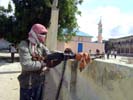
As cataclysmic reports continue to emerge from Somalia, where the Transitional Federal Government, or TFG, is battling to survive an onslaught by the militant group al-Shabaab, the United States has admitted to more overt involvement in trying to stabilize the flagging government.
Speaking to reporters last week, a senior State department official acknowledged that the U.S. government is providing arms and military training to help Somalia’s government beat back the Shabaab, a group the U.S. alleges has ties to al-Qaeda. The senior official explained the concern:
A government run by al-Shabaab would be a government that would likely generate greater instability in the country, carrying out more of the atrocities and human rights violations, and would probably contribute to the continued instability and concerns that we have about providing a safe haven for global terrorists like Fazul Harun and Ali Nabhan, who were responsible for the 2002 bombings [of an Israeli-owned hotel in Mombasa, Kenya].
Shabaab quickly reacted by saying that the move would “only escalate violence in Somalia” and vowing to seize the weapons.
To address the threat of Shabaab, the U.S. government would do “as much as we can” to support the TFG, the African Union forces in Somalia, and the countries of the region, the official said, though he made clear that no U.S. military forces were operating in Somalia or in the region in support of this effort.
Rep. Adam Smith (D-WA), chairman of the House Armed Services subcommittee on terrorism, indicated to the Associated Press that the U.S. options for engaging in Somalia are limited.
Job one would be trying to bring some semblance of order to Somalia, and if that is your objective, there is only one game in town — and that is the government that is there.
However, Rep. Smith’s comment overlooks the fact that the TFG might not still be standing were it not for the presence of African Union troops defending the capital.
The U.S. move raises questions about both the short- and long-term effect that sending shipments of small arms will have on a country that in recent years has been the scene of the most grotesque human rights violations. Since the Shabaab offensive began in early May, an estimated 160,000 have fled intense fighting in Mogadishu alone, according to the United Nations. During a particularly violent two-week period, at least 200 were killed in the capital.
U.S. government officials continue to put forth a holistic view of what needs to be done to ward off the threat of Somalia becoming a terrorist hotbed:
We do not want to see Somalia become a safe haven for foreign terrorists, and we believe that one of the best ways to prevent that is to help the TFG establish itself as a strong, legitimate government capable of enforcing its laws, protecting its borders, and arresting individuals who are working against them as well as against us and others in the international community.
However, in light of this most recent description of U.S. efforts, the best strategy for supporting a stable Somalia in the long-run seems to still elude the Obama administration. It is difficult to see how these aspirations for Somalia, as described above, will be achieved by sending arms to the current fragile government.
Photo: Anti-government fighter in Mogadishu

